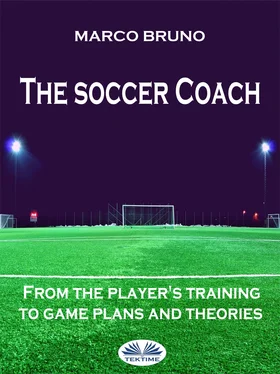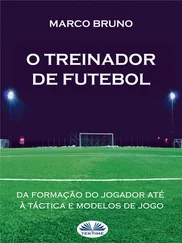Marco Bruno - The Soccer Coach
Здесь есть возможность читать онлайн «Marco Bruno - The Soccer Coach» — ознакомительный отрывок электронной книги совершенно бесплатно, а после прочтения отрывка купить полную версию. В некоторых случаях можно слушать аудио, скачать через торрент в формате fb2 и присутствует краткое содержание. ISBN: , Жанр: unrecognised, на английском языке. Описание произведения, (предисловие) а так же отзывы посетителей доступны на портале библиотеки ЛибКат.
- Название:The Soccer Coach
- Автор:
- Жанр:
- Год:неизвестен
- ISBN:978-8-87-304550-2
- Рейтинг книги:5 / 5. Голосов: 1
-
Избранное:Добавить в избранное
- Отзывы:
-
Ваша оценка:
- 100
- 1
- 2
- 3
- 4
- 5
The Soccer Coach: краткое содержание, описание и аннотация
Предлагаем к чтению аннотацию, описание, краткое содержание или предисловие (зависит от того, что написал сам автор книги «The Soccer Coach»). Если вы не нашли необходимую информацию о книге — напишите в комментариях, мы постараемся отыскать её.
The Soccer Coach — читать онлайн ознакомительный отрывок
Ниже представлен текст книги, разбитый по страницам. Система сохранения места последней прочитанной страницы, позволяет с удобством читать онлайн бесплатно книгу «The Soccer Coach», без необходимости каждый раз заново искать на чём Вы остановились. Поставьте закладку, и сможете в любой момент перейти на страницу, на которой закончили чтение.
Интервал:
Закладка:
c) order of priority and the logical sequence - you cannot effectively teach different aspects of the game at once;
- between two factors, one will always have a logical precedence over the other. If you do not respect a logical sequence, it becomes all the more difficult. The same happens if you insist on teaching the right things, but at the wrong time. Close attention must be paid to the planning and organization.
d) planning and organization.
the planning involves the best use of the equipment and must be done in advance to give rise to the best possible organization.
The organization of an effective training session includes:
the choice of the area of the field to be used for training;
the right number of players participating;
a realistic training (players must be used in their real positions and during the exercises they should play in a realistic way, the goalies must always be regular because the two essential aspects of soccer are the shoots and the scoring);
an adequate start of the exercise and quality of the steps (many workouts are dragged wearily because little attention is given to the way to start the exercise and the steps are sloppy);
simplicity and clarity (all players must understand what you want to do and get with that kind of training).
e) ability to observe: the observation of a training session must lead the technician to understand if:
- the training takes place in accordance to the organization;
- the attitude of the players is stimulated and interested;
- the action of collective play reaches its goal;
- the specific action of the individual is beneficial to the group work.
If all this is not achieved, ask yourself some questions:
- physically, is the player able to perform that task?
if the answer is "no", there is no reason to continue the exercise.
- does the exercise scare the player?
if the answer is "yes", it is better to start with the simplest exercises and further encouraging the player.
- is it a technical problem?
- what technique is it?
make sure the player understands where he is wrong and explain how to do it correctly and train him in this way.
- is it a tactical problem?
1 lack of understanding (isolate and explain the individual parts);
2 lack of intuition (the player does not see the action that takes place for three reasons:
- too crowded action;
- too fast action;
- plays with his head down.
1 lack of application (the player understands what it’s required from him, but he misses the execution because he tries to make things too difficult).
f) communication: all that has been said so far does not matter if the coach is not able to communicate. A coach can communicate in two ways:
1 by demonstration, highlighting the following qualities:
- correct game actions;
- actions carried out in a simple way;
- clear demonstration, highlighting the main factor;
- set a minimum target;
1 by the word: communication through speech is very important, but it depends on the conviction with which he speaks the coach. Before speaking, the coach must think for a moment about what he has to say to be sure of the meaning of the words; must avoid words or complicated speeches and watch the audience while talking. Finally, he must always speak positively because it is more effective to say “do this” instead of saying “you were wrong doing this”.
Communication in figures
We spend 70% of our lives communicating verbally. This time is as follows:
hearing 45%
talking 30%
reading 15%
writing 10%
Of all this we can remember:
of what we read 10%
of what we hear 20%
of what we observe 30%
of what we hear and observe 50%
of what we say 80%
of what we explain 90%
In a conversation we can:
listen 50% of what is said;
hear and listen 50% of what we listen (only 25%);
understand 50% of what we hear (only 12.5%);
believe 50% of what we understand (only 6.25%);
remember 50% of what we believe (only 3.125%).
How many times have we talked for a long time with our athletes?
What is left of our words?
3.125%!!!!!!!!!!
Everything else is forgotten.
To train means to communicate. Some speak but communicate little and struggle to enter into a relationship, while others speak too much and leave little time to listen.
Every teacher must always keep in mind the importance of the sequence:
I LISTEN = I FORGET
I SEE = I REMEMBER
I EXECUTE = I LEARN
Teaching during the game
The coach must be very skillful and careful in training matches. The training match is the culmination of the session, the final development of a good team action. The techniques and exercises in small groups are like pieces of a mosaic and teaching to put them into practice during the game is like trying to complete the mosaic. It is too optimistic to expect that those pieces go alone in their place. To obtain satisfactory and useful results, it is appropriate to establish:
- what to teach;
- where to teach;
- how to teach.
1) What to teach:
we must focus primarily on objectives aimed at improving teamwork.
Defense: reduce time and space; tackle and cover; mass defense.
Offense: creation and exploitation of spaces; passages and movements; mass offense.
All of this goes independently of a game strategy. Every player must learn to behave effectively in every situation.
Accustom the players to make the right calculation:
- between security and risk;
- the possibilities; know how to choose and perform what is best in a particular situation.(best choice)
2) Where to teach:
players must practice playing game actions in every part of the field. Improvements in offensive team play should come from the defensive three quarters of the field, in the same way the improvement of the defensive system should be achieved starting from three-quarters of offense. I think it is appropriate to carry out situational exercises in the different areas of the field or in the areas where we want these behaviors to be actually performed in the game.
3) How to teach: the methods that underlie the teaching are:
- control of the game (e.g. if a team has to train to create spaces on the central band of the field then the training must be limited to that area);
- game conditions (e.g. if you have to concentrate on the quick passage you have to impose the direct game, where possible, and in any case a continuous movement without a ball in advance on the decision of the partner to be able to give him the passage solution even before he receives the ball. If a shot is requested on the support, it is necessary to impose that the player must overtake the teammate to whom the ball has passed);
- stop the game. It is a method to show the players the advantages and disadvantages of their positions.
In this regard it is necessary that:
a) a signal known to all is fixed to stop the game (e.g. two whistle blows, but on this point I am convinced that the signal must necessarily be visual as the coach cannot use the whistle and therefore the players must visually recognize a situation common to all so that in recognizing it, everyone behaves as established in training);
b) the players stop so as not to alter the game situation you want to correct (it is advisable to stop the game to emphasize the theme, but not to deal with different themes).
- correct and try again: after having stopped the game it is important to try again in the correct way what has been done in the wrong way.
- thinking aloud: it is a method by which the coach thinks out loud in place of the player, anticipating his actions. This method is often used to make corrective repetition more effective.
Читать дальшеИнтервал:
Закладка:
Похожие книги на «The Soccer Coach»
Представляем Вашему вниманию похожие книги на «The Soccer Coach» списком для выбора. Мы отобрали схожую по названию и смыслу литературу в надежде предоставить читателям больше вариантов отыскать новые, интересные, ещё непрочитанные произведения.
Обсуждение, отзывы о книге «The Soccer Coach» и просто собственные мнения читателей. Оставьте ваши комментарии, напишите, что Вы думаете о произведении, его смысле или главных героях. Укажите что конкретно понравилось, а что нет, и почему Вы так считаете.












